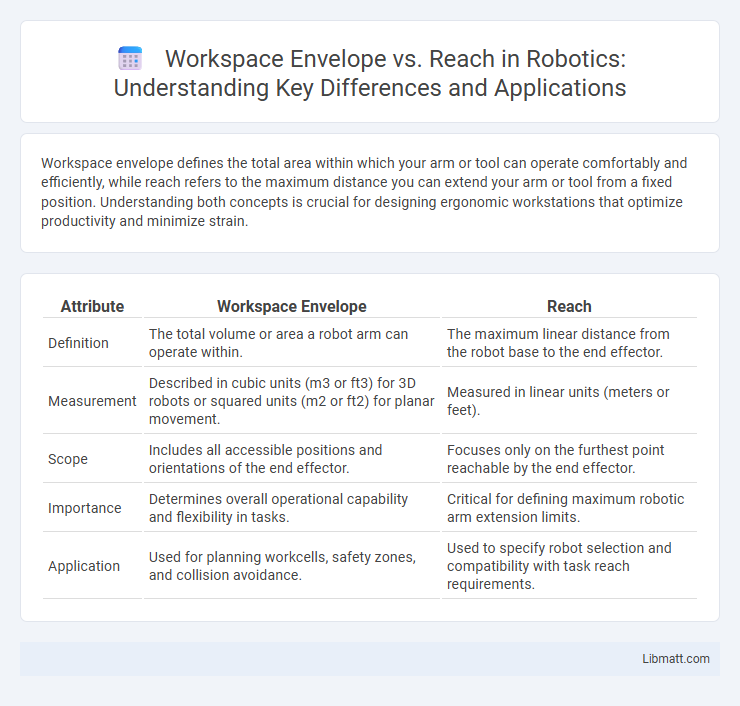Workspace envelope defines the total area within which your arm or tool can operate comfortably and efficiently, while reach refers to the maximum distance you can extend your arm or tool from a fixed position. Understanding both concepts is crucial for designing ergonomic workstations that optimize productivity and minimize strain.
Table of Comparison
| Attribute | Workspace Envelope | Reach |
|---|---|---|
| Definition | The total volume or area a robot arm can operate within. | The maximum linear distance from the robot base to the end effector. |
| Measurement | Described in cubic units (m3 or ft3) for 3D robots or squared units (m2 or ft2) for planar movement. | Measured in linear units (meters or feet). |
| Scope | Includes all accessible positions and orientations of the end effector. | Focuses only on the furthest point reachable by the end effector. |
| Importance | Determines overall operational capability and flexibility in tasks. | Critical for defining maximum robotic arm extension limits. |
| Application | Used for planning workcells, safety zones, and collision avoidance. | Used to specify robot selection and compatibility with task reach requirements. |
Understanding Workspace Envelope and Reach
Workspace envelope defines the total three-dimensional space within which a robotic arm or human operator can move and perform tasks, ensuring maximum efficiency and safety. Reach refers to the maximum linear distance from the base or pivot point to the furthest point the arm or hand can extend, directly impacting task accessibility and operational flexibility. Optimizing both workspace envelope and reach is essential for designing ergonomic workstations and enhancing productivity in industrial automation and human-machine interfaces.
Defining Workspace Envelope in Ergonomics
Workspace envelope in ergonomics defines the three-dimensional area within which you can comfortably reach, manipulate, and interact with objects while maintaining an optimal posture. It ensures tasks are designed to minimize strain and enhance efficiency by considering the natural range of motion of your arms and hands. Understanding your workspace envelope allows for customized workstation layouts that reduce fatigue and improve productivity.
The Concept of Reach: What Does It Mean?
The concept of reach refers to the extent or range within which Workspace envelope services can effectively access and manage resources, applications, or user data. Reach determines how widely your Workspace can connect across different networks or geographic locations, impacting performance and availability. Understanding reach helps optimize user experience by ensuring Workspace services maintain seamless and secure connections wherever users operate.
Key Differences Between Workspace Envelope and Reach
Workspace envelope defines the maximum spatial boundaries within which a worker can operate safely and efficiently, incorporating all reachable points without straining. Reach, in contrast, specifically measures the maximum linear distance a worker can extend their hand or tool from a fixed position. The key difference lies in workspace envelope encompassing a three-dimensional volume of accessible space, while reach focuses on a singular directional extension.
Importance of Workspace Envelope in Design
The Workspace Envelope defines the maximum spatial boundaries within which all design elements must fit, ensuring efficient use of available space and compliance with ergonomic standards. Accurate determination of the Workspace Envelope optimizes layout planning, enhances user comfort, and reduces operational risks by preventing overcrowding or unnecessary movements. Prioritizing Workspace Envelope in design leads to improved workflow, increased productivity, and safer working environments.
Human Reach Factors and Limitations
Workspace envelope defines the maximum area a person can physically reach without moving their torso, relying on arm length and joint mobility, while Reach encompasses both this area and the extended zone accessible by shoulder and torso movement. Human reach factors include joint flexibility, strength, body size, and task-specific constraints such as fatigue and posture stability. Limitations arise from physiological boundaries, ergonomic strain, and the need to maintain balance and comfort during repeated or sustained reach tasks.
Applications of Workspace Envelope in Industrial Settings
Workspace envelope defines the three-dimensional area within which a robotic arm or machine operates, ensuring efficient use of space and reducing collision risks in industrial environments. Applications include precision assembly lines, welding stations, and material handling systems where spatial constraints and safety are critical. Optimizing your workspace envelope improves productivity by tailoring machine movements to specific operational zones, enhancing both accuracy and workflow.
Optimizing Reach for User Comfort and Safety
Optimizing Reach within a workspace envelope enhances user comfort and safety by minimizing excessive stretching and awkward postures that lead to strain injuries. Proper reach zones tailored to ergonomic standards ensure that frequently used tools and controls are positioned within the primary reach area, reducing the risk of musculoskeletal disorders. Implementing adjustable workspaces that accommodate diverse body sizes and reach capabilities further promotes sustained productivity and injury prevention.
Comparing Workspace Envelope vs. Reach in Workstation Design
Workspace envelope defines the total physical area that your workstation occupies, encompassing all equipment and materials, while reach refers to the maximum distance your arms can extend comfortably to access tools or controls. Designing with an optimized workspace envelope ensures efficient use of space and reduces unnecessary movement, whereas focusing on reach enhances ergonomic accessibility and minimizes strain. Balancing these factors in workstation design improves productivity and promotes user comfort by tailoring spatial layout to human reach capabilities.
Best Practices for Integrating Workspace Envelope and Reach
Integrating Workspace Envelope and Reach requires aligning access controls in Workspace Envelope with user permissions in Reach to ensure seamless workflow and security. Utilize synchronized identity management systems and regular audits to maintain consistency and prevent unauthorized access. Optimizing API integration between Workspace Envelope and Reach enhances data flow efficiency and supports scalable collaboration across platforms.
Workspace envelope vs Reach Infographic

 libmatt.com
libmatt.com